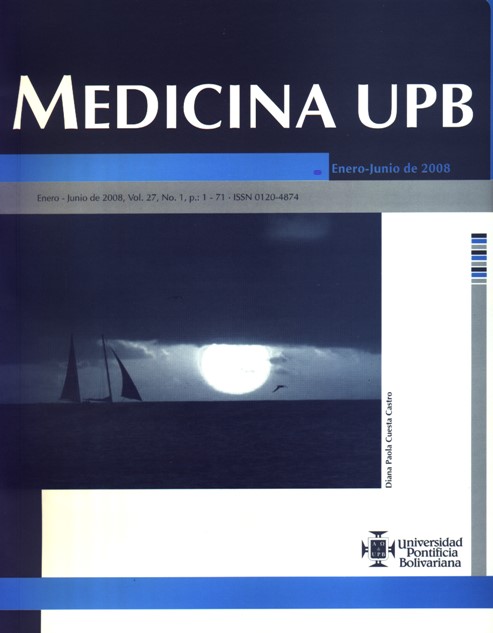Enfermedad de Creutzfeldt-Jakob esporádico: síntomas neuropsiquíatricos seguidos de daño cognitivo progresivo: reporte de caso
Contenido principal del artículo
Resumen
La enfermedad de Creutzfeldt-Jakob (ECJ) es la enfermedad por priones más común y es la única entre los desórdenes humanos que se puede presentar en forma familiar, esporádica y transmitida. La hipótesis prevalente, basada en numerosos estudios en ratones transgénicos, sugiere que la ECJ y otras enfermedades por priones se inician y propagan por conversión de una proteína prionica normal (PrP) en una isoforma conformacional anormal (PrPreS). Esta última se acumula en el cerebro y es una de las características bioquímicas importantes en ECJ. Se reporta el caso de una mujer de 37 años de edad, quien murió en un hospital de tercer nivel por ECJ esporádico comprobado por autopsia. Este caso muestra la importancia de un examen post-mortem para confirmar el diagnóstico. A la luz de la observación clínica, discutimos el caso, el cual debe ser considerado en pacientes que evolucionan a una demencia rápidamente progresiva.
Referencias
Castellani RJ. Variant Creutzfeldt-Jakob Disease an overview. Pathology Case Reviews 2004; 9:16-19
Colchester ACF, Colchester NTH. The origin of bovine spongiform encephalopathy: the human prion disease hypothesis. Lancet 2005; 366: 856-861.
Goldman JS, Miller BL, Safar JG, Tourreil S, Martindole JL, Prusiner SB, Geschwind MD. When sporadic disease is not sporadic. The potential for Genetic Etiology. Arch Neurol 2004; 61: 213 -216.
Glatzzel M, Stoeck K, Seeger H, Luhrs T, Aguzzi A. Human prion diseases: molecular and Clinical aspects. Arch Neurol 2005;62:545 -552
Collinge J. Molecular neurology of prion disease. J Neurol Neurosurg Psychiatry 2005; 76:906 -919.
Satoh J, Onoue H, Arima K, Yamamura T. The 14-3-3 protein forms a molecular complex with heat shock protein Hsp60 and cellular prion protein. J Neuropathol Exp Neurol 2005; 64(10):858-68.
Kovacs GG, Puopolo M, Ladogana A, Pocchiari M, Budka H, van Duijn C, et al. Genetic prion disease: the EUROECJ experience. Hum Genet 2005;118(2):166- 74.
Brown P. Blood infectivity, processing and screening tests in transmissible spongiform encephalopathy. Vox Sang 2005;89(2):63-70.
Bastian FO, McDermott ME, Perry AS, Carver LA, Dash S, Garry RF. Safe method for isolation of prion protein and diagnosis of Creutzfeldt-Jakob disease. J Virol Methods 2005;130(1-2):133-9
Zanusso G, Ferrari S, Conte S, Mellina V, Sacchi V, Rizzuto N, Monaco S. A 49- year-old man with neuropsychiatric symptoms followed by progressive cognitive decline. Brain Pathology 2006 ; 237-238.
Kawauchi Y, Kamitani T, Saburo Kitamoto YT and Kishida H. Autopsy case of Creutzfeldt–Jakob disease with Met/Val heterozygosity at codon 129 and type protease-resistant prion protein presenting some florid type plaques and many Kuru plaques in the cerebellum. Neuropathology 2006; 26, 313–317.
Morgado-Linares RY, Ruiz-Pena JL, Paramo MD, DiazDelgado M, Izquierdo G. Clinical features of familial Creutzfeldt-Jakob disease and the E200K mutation in Spain. Rev Neurol 2007 Feb 1-15;44(3):150-3
Rodriguez-Uranga JJ, Gil-Neciga E, Pinero P, SerranoPozo A. Diffusion-weighted magnetic resonance sequences in the early diagnosis of Creutzfeldt-Jakob disease. Rev Neurol 2005 Sep 16-30;41(6):378.
Moreno-Izco F, Martinez-Gil A. CreutzfeldtJakob disease: alterations in an isolated cortical signal in diffusion magnetic resonance imaging Rev Neurol 2005 Jan 1-15;40(1):38-42


